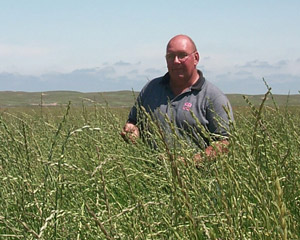Tips to Maximize Forage Yields When Establishing Perennial Forages
March 2015

To maximize forage production in the year that you are establishing perennial forage consider these management strategies.
First consider a late-summer to early-fall seeding for establishment of your cool-season grass pasture and/or hay ground. Research in Nebraska has shown that by planting in the fall one can expect 85% to 90% production the following year either by grazing and/or hay yields compared to 50% production the first year with a spring seeding.
Research has shown that annual forages can be planted in the spring/summer, then either hayed or grazed to increase production with the cool-season grasses being planted in the fall with good success on both irrigated and dryland sites.
There are several options when considering this method of establishment. Oats planted in late March to early April can yield 2.0-3.0 tons of hay or 2-3 AUMs (Animal Unit Months) of grazing per acre. In most cases, a second crop could be planted in early July – such as planting a summer annual like a sorghum/sudan cross, pearl millet, or foxtail millet. Yields with these crops with adequate moisture could yield an additional 2.0-3.0 tons of high quality forage or 3.0 AUMs per acre. Under irrigation or adequate rainfall, and with sufficient amounts of fertilizer, one could expect to harvest a total of 4.0-5.0 tons of hay per acre or 4-6 AUMs of grazing and still establish cool-season grasses.
Inter-seeding into stubble after haying is an excellent option for establishing these cool-season grasses. An application of glyphosate may be needed to kill annual weeds and stop the regrowth of the annual forages planted for hay. The residue left standing allows the new seedlings some shade in late summer, provides a firm seed bed, and will catch snow to protect the new seedlings during the winter.
When planting cool-season grasses always consider the newer improved varieties as some of these have proven to increase rate of gain by 10 to 20% over the older varieties. Some of the improved varieties include Manska, Beef Maker & Hay Maker wheatgrass, and Newel Smooth brome grass.
Three publications for further reading are available.
- Perennial Forages for Irrigated Pasture
- Establishing Dryland Forage Grasses
- Summer Annual Forages for Beef Cattle in Western Nebraska
For more information on using annual forages to establish cool-season grasses, including annual forage selection, fertilizer recommendations, cool-season grass mixes and varieties, seeding rates, etc., please contact me.
Dennis Bauer
Beef Systems
Nebraska Extension Educator
dbauer1@unl.edu